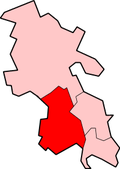| Northend | |
|---|---|
Location within Buckinghamshire | |
| OS grid reference | SU735925 |
| Civil parish | |
| District | |
| Unitary authority | |
| Shire county | |
| Ceremonial county | |
| Region | |
| Country | England |
| Sovereign state | United Kingdom |
| Post town | HENLEY-ON-THAMES |
| Postcode district | RG9 |
| Police | Thames Valley |
| Fire | Buckinghamshire |
| Ambulance | South Central |
| UK Parliament | |

Northend is a village that straddles the border of the two English counties of Buckinghamshire and Oxfordshire. [1] [2] [3] The eastern half is in the civil parish of Turville in Buckinghamshire, while the western half is across the border into Oxfordshire, in the Watlington parish.


